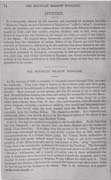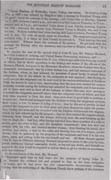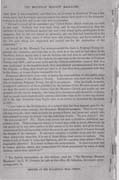
[p. 14]
THE MOUNTAIN MEADOW MASSACRE.
In the summer of 1857, a company of emigrants passed through Utah, en route for California. They took what is known as the southern route, and while, going through some of the settlements in Southern Utah, they were both impertinent and abusive. They poisoned several springs, and also the carcass of an ox which had died. Several Indians drinking the water and eating the carcass died from the effects. The result was that the Indians became enraged, and being joined by a few white men—among them John D. Lee—who, unfortunately, were Mormons, the entire company, excepting a number of children, were cruelly and inhumanly murdered. This horrid crime has been charged upon the Mormon Church, and especially upon the leading Elders. The charge is not true. It is wickedly and maliciously false; was proven to be so by the repeated failure of the efforts of his enemies to fasten the crime upon Brigham Young.
John D. Lee had two trials for complicity in the horrid affair. In the first trial the jury disagreed. At the second trial, one James Haslam gave the testimony which I here introduce. It is taken from the records of the court. But that the reader may understand its force, I may briefly explain that in 1857, upon the misrepresentations of a United States judge, the United States authorities at Washington had rashly ordered armed forces to Utah to put down a supposed rebellion of the Mormon people, and in consequence of that "army" approaching Utah, there was considerable excitement throughout the Territory. This fact made the emigrants passing through Utah both arrogant and abusive to the people of the "Mormon" settlements, and a council of leading men in those settlements was held to determine upon the course to be pursued towards the emigrants, and it was decided to send a messenger to Brigham Young to learn his views upon it. That messenger was Haslam; but before he returned the massacre had taken place—John D. Lee having led the Indians to the attack. This is his testimony as it appears on the court records:—

[p. 15]
"James Haslam, of Wellsville, Cache Valley, was sworn. He lived in Cedar City in 1857; was ordered by Haight to take a message to President Young with all speed; knew the contents of the message; left Cedar City on Monday, September 7, 1857, between 5 and 6 p.m., and arrived at Salt Lake on Thursday at 11 a.m.; started back at 3 p.m., and reached Cedar about 11 a.m. Sunday morning, September 13th; delivered the answer from President Young to Haight, who said it was too late. Witness testified that when leaving Salt Lake to return, President Young said to him, 'Go with all speed, spare no horseflesh. The emigrants must not be meddled with, if it takes all Iron County to prevent it. They must go free and unmolested.' Witness knew the contents of the answer. He got back with the message the Sunday after the massacre, and reported to Haight, who said, 'It is too late.'"
In opening the case at the second trial of John D. Lee, Mr. Sumner Howard, Ex-Chief Justice of Arizona, and United States Prosecuting Attorney, said :—
"He proposed to prove that John D. Lee, without any authority from any council or officer, but in direct opposition to the feelings and wishes of the officers of the Mormon Church, had gone to the Mountain Meadows, where the Indians were then encamped, accompanied only by a little Indian boy, and had assumed command of the Indians, whom he had induced, by promises of great booty, to attack these emigrants; that in his attack on the emigrants he was repulsed; that finding he could not get the emigrants out, he sent word to the various settlements of Southern Utah for men to be sent to him, representing that the men were needed for various purposes, to some saying the Indians had attacked the emigrants, and it was necessary to have men sent to draw off the Indians, to others that men were necessary to protect the emigrants, and still others that the emigrants were all killed, and that they were required to bury the dead; these men went in good faith to perform a humane act; that he had arranged with the Indians to bring the emigrants out from their corral, or fort, by means of a flag of truce; that by this act of perfidy he had induced the emigrants to give up their arms and place themselves under his protection, loading the arms and the wounded with the helpless children into two wagons, which he had ordered up for the purpose; that he then started the wagons ahead, following them himself, and the women following next, the men bringing up the rear in single file; that Lee, after having traveled from three-quarters of a mile to a mile, gave the order to fire, and the slaughter commenced; that Lee shot one woman with his rifle, and brained another woman; then drawing his pistol, shot another, and seizing a man by the collar and drawing him out of a wagon, cut his throat; that he gathered up the property of the emigrants and took it to his own place, using and selling it for his own benefit and use. All these charges against John D. Lee, he (District Attorney Howard) proposed to prove to the jury by competent testimony beyond reasonable doubt, or beyond any doubt, and thought no appeal to the jury would be required to induce them to give a verdict in accordance with the evidence,"
At the conclusion of the trial, Mr. Howard
"Repeated again that he had come for the purpose of trying John D. Lee, because the evidence led and pointed to him as the main instigator and leader, and he had given the jury unanswerable documentary evidence proving that the authorities of the Mormon Church knew nothing of the butchery

[p. 16]
until after it was committed, and that Lee, in his letter to President Young a few weeks later, had knowingly misrepresented the actual facts relative to the massacre seeking to keep him still in the dark and in ignorance.
"He had received all the assistance any United States official could ask on earth in any case. Nothing had been kept back, and he was determined to clear the calender of every indictment against any and every actual guilty participator in the massacre, but he did not intend to prosecute any one that had been lured to the meadows at the time, many of whom were only young boys, and knew nothing of the vile plan which Lee originated and carried out for the destruction of the emigrants."
As stated by Mr. Howard, Lee misrepresented the facts to Brigham Young respecting the massacre, and kept him in the dark as to the part he had taken in the butchery, always saying that it was the Indians who had done it, and whom he tried in vain to restrain. Nor did the facts in the case come to the knowledge of Brigham Young until 1870; and as soon as he and the Church authorities learned that Lee was implicated in the heartless deed, they immediately excommunicated him from the Church,—a thing they would not dare to do had they been connected with him in the crime, or in any degree responsible for it.
Numerous efforts have been made to fasten the responsibility of this awful crime upon the leaders of the Mormon Church. Inducements were held out to John D. Lee to implicate Brigham Young, but all to no purpose. After his death, however, a supposed confession of his is published by the enemies of the Mormon people, and on that the world is asked to believe that the Mormon Church and people are responsible for the bloody tragedy; the thing is too monstrous and absurd for credence. And no people more emphatically condemn that crime than do the Latter-day Saints. Of it the late President John Taylor said, in an article he furnished for the press, in 1882:—
"I now come to the investigation of a subject that has been harped upon for the last seventeen years, namely, the Mountain Meadows massacre. That bloody tragedy has been the chief stock-in-trade for penny-a-liners, and press and pulpit, who have gloated in turns by chorus over the sickening details. 'Do you deny it?' No. 'Do you excuse it?' No. There is no excuse for such a relentless, diabolical, sanguinary deed. That outrageous infamy is looked upon with as much abhorrence by our people as by any other parties in this nation or in the world, and at its first announcement its loathing recital chilled the marrow and sent a thrill of horror through the breasts of the listeners. It was most certainly a horrible deed, and like many other defenceless tragedies, it is one of those things that cannot he undone. The world is full of deeds of crime and darkness, and the question often arises—Who is responsible therefor? It is usual to blame the perpetrators. It does not seem fair to accuse nations, states, and communities for deeds perpetrated by some of their citizens, unless they uphold it."*
PRINTED AT THE MILLENNIAL STAR OFFICE.